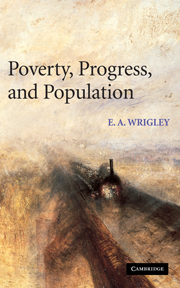Book contents
- Frontmatter
- Contents
- List of figures
- List of tables
- Acknowledgements
- Introduction
- PART I The wellsprings of growth
- 1 The quest for the industrial revolution
- 2 The divergence of England: the growth of the English economy in the seventeenth and eighteenth centuries
- 3 Two kinds of capitalism, two kinds of growth
- 4 Men on the land and men in the countryside: employment in agriculture in early nineteenth-century England
- 5 The occupational structure of England in the mid-nineteenth century
- 6 Corn and crisis: Malthus on the high price of provisions
- 7 Why poverty was inevitable in traditional societies
- 8 Malthus on the prospects for the labouring poor
- PART II Town and country
- PART III The numbers game
- Bibliography
- Index
4 - Men on the land and men in the countryside: employment in agriculture in early nineteenth-century England
Published online by Cambridge University Press: 23 December 2009
- Frontmatter
- Contents
- List of figures
- List of tables
- Acknowledgements
- Introduction
- PART I The wellsprings of growth
- 1 The quest for the industrial revolution
- 2 The divergence of England: the growth of the English economy in the seventeenth and eighteenth centuries
- 3 Two kinds of capitalism, two kinds of growth
- 4 Men on the land and men in the countryside: employment in agriculture in early nineteenth-century England
- 5 The occupational structure of England in the mid-nineteenth century
- 6 Corn and crisis: Malthus on the high price of provisions
- 7 Why poverty was inevitable in traditional societies
- 8 Malthus on the prospects for the labouring poor
- PART II Town and country
- PART III The numbers game
- Bibliography
- Index
Summary
The main purpose of this essay is to re-examine the census evidence about the size of the agricultural labour force in England in the first half of the nineteenth century. Because of the limitations of the census data, the review is conducted chiefly in terms of the totals of adult males engaged in agriculture. It reinforces the conclusions of others who have considered the same evidence – that there was very little expansion of employment on the farm in this period. Indeed, taken in conjunction with my more conjectural estimates of agricultural employment in earlier centuries, it seems reasonable to suggest that in the quarter-millennium between 1600 and 1850 employment on the land rose by no more than a third, although the population of England rose more than fourfold and remained very largely home fed.
However, there is a subsidiary theme, as the title suggests. Although employment in agriculture rose so modestly, by perhaps a tenth between 1811 and 1851 (table 4.12), the population of rural England continued to grow vigorously during most of the first half of the century. It was only after 1850 that stagnation set in. Men on the land may have increased very little, but the number of men in the countryside grew by roughly a half between 1811 and 1851, and employment outside agriculture but in rural areas therefore grew faster still.
It has occasionally been supposed that the rapidly rising English labour force of the period, no longer able to find work on the land, turned principally to industrial employment as a means of support, whether in the new formof the factory or in the older form of domestic industry.
- Type
- Chapter
- Information
- Poverty, Progress, and Population , pp. 87 - 128Publisher: Cambridge University PressPrint publication year: 2004



